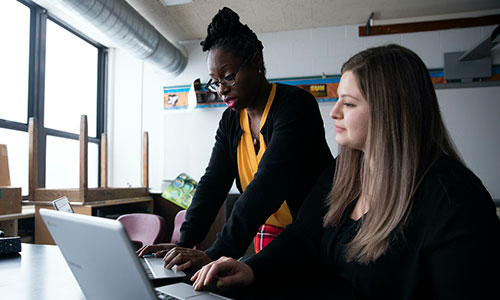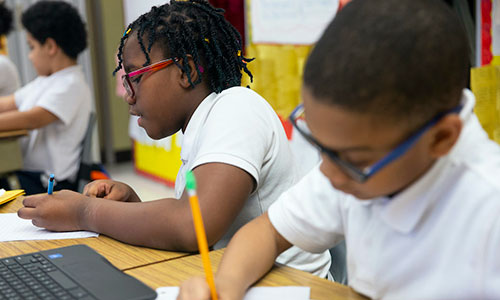
Did you know that kids can smell inauthenticity? Middle school math teacher Kailey Rhodes recently shared this friendly word of caution on The Continuing Educator podcast. Kailey and her co-host, Jacob Bruno, executive vice president of Learning & Improvement Services at NWEA, chatted about how to establish an easy and natural rapport with students, and why an authentic classroom culture matters so much.
In “Ask your kids what they want! And other secrets of building a better classroom culture,” Kailey and Jacob reflected on what they’ve learned about how to establish an authentic classroom culture that fosters trust and helps students thrive. If you’re a teacher looking for new ways to improve your own classroom culture, here are five tips and best practices to keep in your back pocket.
1. Ask your kids about their experience
“At the start of the year, I always [ask my students to share] things they have not enjoyed about previous classrooms,” says Kailey. “It’s a little controversial, because it does kick off the year with them reliving some negativity. However, [when they share] these anecdotes with me, I learn so much about them.”
By starting the year this way, teachers can learn things about their students that otherwise might not surface until much later, if at all. Kailey recalls students telling her about moments when they felt rushed by their teachers or disrespected by their peers. She has also heard stories from kids who felt that their learning styles weren’t valued or that teachers liked other kids better. Teachers should tread carefully in asking kids to share some of their less happy memories in the classroom, but it’s undeniable that a great deal can be learned this way.
“Just giving a voice to [these experiences] in a classroom is such a gift to me, and I love hearing about it and spending a few days actively listening,” says Kailey. “We put these things on giant Post-Its and talk about what a healthy classroom looks and feels like.”
To this day, Kailey has some words of wisdom posted on her classroom wall that originated in these kinds of conversations. For example:
- “A good classroom knows the difference between laughing at and laughing with.”
- “I don’t want the work to be too hard, but I don’t want it to be too easy.” (Kids know all about the zone of proximal development, as it turns out.)
- “We want the work to feel spicy. We can still chew and swallow it, but it’s got a little heat.”
2. Humanize yourself (a.k.a. don’t be afraid to mess up)
Even though teachers need to be in command of the classroom and earn students’ trust, kids will respond positively to teachers who reveal that they, too, are just people, says Kailey. Whether you have a scratchy voice because you didn’t sleep well or you came to class without the handouts you meant to bring, it’s okay to be honest with students when you’re not at your best. “It’s an intentional lack of polish that helps them show up with their own lack of polish,” says Kailey.
Kailey’s co-host, Jacob Bruno, agrees that vulnerability and strength in the classroom go hand in hand. “I actually think it’s powerful … this notion of struggling with an idea, struggling with a problem, but sticking with it,” he says. “It’s okay not to know, and it’s okay to get help. When kids see a teacher do that, it gives them permission to do it, too.”
3. Get them sharing with each other
Ideally, students are more than just classmates—they’re allies, too. According to Kailey, a major benefit of asking kids to share their experience with you, as described above, is that they learn about each other in the process. “When one shares, another can relate,” she says, “and they can connect over these shared experiences and desires.”
Jacob points out that among older kids, there may be fewer built-in opportunities for sharing in the classroom. “Younger kids are more of a cohort,” he explains, “and older kids are more independent and in the college prep mindset. Do [the older kids] have an opportunity to learn about each other in a safe and structured environment, so community can be built and we can do group work together?” Jacob emphasizes that simply noticing and being aware of each other can help kids thrive in all kinds of ways, including academically, which leads to a stronger classroom culture.
4. Recognize moments of kindness
Kailey stays alert for small gestures of kindness between students that might otherwise go unnoticed, so that she can celebrate and reinforce the importance of these fleeting moments. For example, when one of her students compliments a peer—even in a small way—Kailey tries, in an understated way, to praise the student for showing kindness and a generosity of spirit.
Of course, students are not always gentle with each other, and Kailey keeps her ears open for unkind words, too. If she feels the need to intervene in an edgy exchange between students, she does so “with love and compassion, not punitively,” she says. She might say, “Hey, I think you’re trying to joke, but it came out unkind. Can we have a redo?” In this way, tension can be eased and students can get valuable firsthand examples of healthy communication.
5. Build rapport
All of the tips we’ve described so far—asking students about their past experiences, showing your human vulnerability as a teacher, getting kids to share with each other, and calling out moments of kindness—work together toward the overarching goal of building strong rapport in the classroom. This means rapport between not only teacher and student, but also student to student as well. Teachers who remind themselves regularly of the importance of good rapport will naturally find ways to maintain it, whether by using tried-and-true practices or trying some novel approaches.
For Kailey, inviting students to complete informal surveys is a golden opportunity to learn about them and begin earning their trust—the foundation of rapport and a requirement of a strong classroom culture. To get their attention, she asks them personal (and sometimes silly) questions like, “What song is part of your life?” “Are you a mermaid or a falcon?” The questions may seem a bit random, but the intention is anything but, as Kailey explains: “First, does every student in this room know that I, the teacher and the adult, care about them? And two, have I created a space where each student has the opportunity to make a connection with at least one other like-minded kiddo? They don’t all need to be best friends, but I want to know that I’ve done enough … that they can make at least one connection.”
Hear more
Want to hear the whole conversation between Kailey and Jacob? Listen to their podcast episode, and then start brainstorming your own ways to create an authentic classroom culture.







